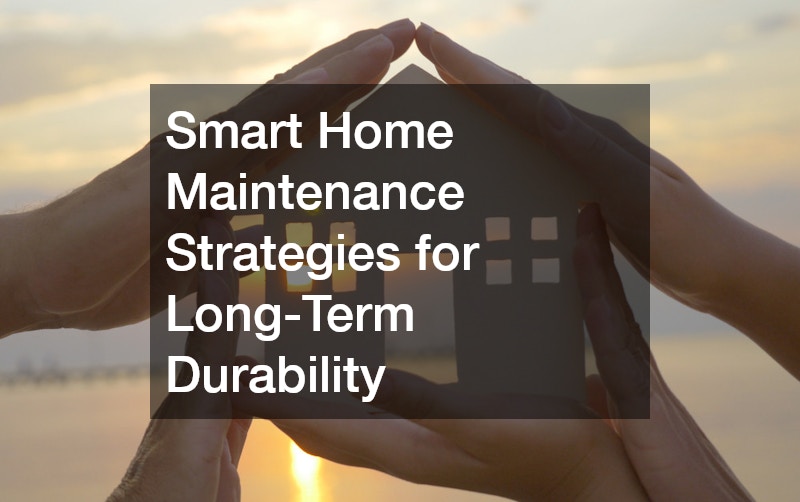Maintaining a home isn’t just about aesthetics—it’s about protecting your largest investment and ensuring it functions efficiently for years to come. Smart home maintenance strategies prioritize proactive care over reactive repairs, enabling homeowners to prevent costly issues before they occur. From seasonal inspections to system upgrades, a well-planned approach to long-term durability can make the difference between a home that requires constant attention and one that practically takes care of itself. With technology-driven solutions, expert assistance, and regular upkeep, homeowners can extend the life of their property, save money, and maintain comfort year-round.
Preventive Care Through Routine Inspections
Preventive care is one of the most valuable aspects of smart home maintenance. Regular inspections help identify small problems before they turn into expensive disasters. Homeowners who schedule routine evaluations of their roofing, electrical systems, plumbing, and foundation can address wear and tear early on. A visual inspection of the roof, for example, may reveal missing shingles or flashing issues that can lead to leaks if ignored. Similarly, checking for cracks in the foundation or pooling water around the home’s perimeter can prevent structural damage.
Professional assessments play a major role in this process. Experienced local roofers can spot early signs of deterioration that an untrained eye might overlook. They can also recommend timely maintenance, such as sealing minor cracks or replacing damaged materials, to avoid costly full replacements later. These preventive steps go a long way toward protecting the overall structure of the home.
Technology now makes inspections easier and more efficient. Drone roof inspections, smart water sensors, and thermal imaging tools allow professionals to assess damage without invasive methods. By combining these innovations with regular upkeep, homeowners can make informed decisions that protect their investment. Preventive care not only enhances safety but also boosts energy efficiency, since systems that are routinely maintained tend to perform at peak levels.
Routine inspections should be scheduled seasonally or annually, depending on the system being evaluated. Roofing and HVAC systems often benefit from semi-annual checks, especially before major weather changes. Keeping a maintenance calendar ensures that every aspect of the home—from the attic to the basement—receives proper attention. By following a preventive schedule, homeowners reinforce the long-term durability of their property and reduce unexpected repair costs.
Seasonal Strategies for Energy Efficiency
Energy efficiency is central to smart home maintenance, particularly as energy costs continue to rise. Seasonal maintenance strategies keep systems running efficiently while minimizing waste. During summer, focus on ventilation, cooling, and insulation. Clean air filters, check for duct leaks, and ensure vents are unobstructed. These simple actions improve airflow and reduce strain on cooling units. In winter, sealing drafts and adding insulation around windows and doors helps retain heat, reducing energy loss.
Regular HVAC repairs are a critical component of these seasonal strategies. Over time, dirt and debris accumulate in air conditioning units and furnaces, causing them to work harder and consume more energy. A professional technician can inspect the system, replace filters, and recalibrate components for optimal performance. Preventive maintenance not only reduces monthly energy bills but also extends the lifespan of expensive equipment.
Smart thermostats add another layer of energy efficiency by allowing homeowners to control temperature settings remotely. Many models learn household routines and automatically adjust temperatures to save energy while maintaining comfort. Combining this technology with consistent system care creates a sustainable approach to managing home energy use.
During seasonal transitions, homeowners should also inspect outdoor elements like weatherstripping, caulking, and insulation. These materials degrade over time and can allow unwanted air exchange between the interior and exterior. Addressing these issues improves comfort and ensures that heating and cooling systems don’t have to overcompensate for leaks.
Ultimately, energy-efficient home maintenance creates both immediate and long-term benefits. It reduces energy consumption, prevents system failures, and helps homeowners maintain a consistent indoor environment year-round.
Protecting Home Systems From Weather Damage
Weather fluctuations can take a significant toll on a home’s exterior and infrastructure. Rain, snow, wind, and heat each pose unique challenges, making it vital to incorporate weather-specific precautions into a comprehensive home maintenance plan.
The garage, for instance, often goes overlooked when discussing weather protection. However, garage door repairs should be a regular part of maintenance to ensure safety and durability. A malfunctioning door can compromise insulation, security, and even structural stability. Weather seals should be replaced periodically to prevent water infiltration and temperature extremes from affecting the garage’s contents.
For homes located in regions with harsh winters, emergency heating repairs can be lifesaving. Unexpected system failures during freezing temperatures can lead to frozen pipes, poor air quality, and safety hazards. Scheduling pre-winter HVAC inspections minimizes these risks by ensuring that heating units are ready to operate at full capacity. Installing surge protectors or backup generators can also provide added peace of mind during severe storms or power outages.
Exterior surfaces such as siding, paint, and decks also need protection from weather-related wear. Applying sealants, repainting faded areas, and replacing damaged boards are cost-effective measures that prevent rot and structural issues. Homeowners should also clear debris from gutters and downspouts to prevent ice dams and water backups that could damage foundations or basements.
Weatherproofing strategies are essential for long-term durability. By proactively addressing potential vulnerabilities—especially those impacted by local climate conditions—homeowners can reduce the risk of costly emergency repairs while preserving the property’s value and comfort.
Plumbing, Drainage, and Water Management
A reliable plumbing system is the foundation of any well-maintained home. Even small leaks can escalate into major water damage if not detected early. Smart plumbing solutions, including leak detectors and moisture sensors, provide real-time alerts when issues arise, helping homeowners act before problems worsen.
Partnering with local plumbing contractors ensures that plumbing systems remain efficient and compliant with safety codes. Professionals can identify corroded pipes, blocked drains, and worn-out components that may otherwise go unnoticed. Routine inspections of pipes, joints, and fixtures can prevent water waste and structural damage, extending the system’s lifespan.
In addition to preventive inspections, timely pipe repair services are crucial for maintaining the integrity of plumbing systems. Whether dealing with a minor leak or a burst pipe, professional repairs protect against water intrusion and mold growth. Advanced techniques such as trenchless pipe replacement minimize disruption to landscaping while offering long-lasting solutions.
Proper drainage also plays an integral role in home maintenance. Gutters and downspouts should direct water away from the foundation, while grading should prevent pooling near the house. Homeowners should also inspect sump pumps regularly to ensure they’re functional before heavy rain seasons begin.
Modern technology has made plumbing management easier than ever. Smart water valves can automatically shut off the main supply during a leak, preventing catastrophic flooding. Combined with regular maintenance from qualified contractors, these tools create a system that prioritizes efficiency, sustainability, and safety.
By keeping plumbing systems in top condition, homeowners not only prevent expensive repairs but also preserve their property’s structural and environmental health.
Landscape and Exterior Care
Maintaining the landscape and exterior surroundings of a home contributes directly to its durability and aesthetic appeal. Healthy lawns, trimmed trees, and clean gutters all help prevent damage to structures and utilities. Overgrown branches or neglected foliage can threaten roofing, windows, and siding, especially during storms.
Engaging professional local tree services ensures that trees are pruned safely and effectively. Experts can identify diseased limbs, assess root stability, and remove hazardous trees before they cause damage. Regular trimming enhances curb appeal while preventing branches from scraping against siding or interfering with power lines.
Beyond trees, landscape maintenance involves proper irrigation and drainage management. Overwatering or poorly designed sprinkler systems can lead to foundation erosion, mold growth, and pest infestations. Mulching garden beds, sealing driveways, and maintaining fences all contribute to a clean and resilient property exterior.
Another key element of outdoor maintenance involves pest prevention. Annual local termite inspection services can identify early signs of infestations that could threaten the home’s structure. Professionals use moisture meters, infrared scanners, and soil probes to detect hidden colonies before they cause extensive damage.
Caring for the exterior of a home requires attention to both function and form. Clean, well-maintained outdoor spaces reflect positively on the homeowner and play a practical role in preserving property value. Regular landscaping not only enhances beauty but also protects the home’s foundation, roofing, and siding from natural wear.

Documentation and Property Evaluation
Documentation is often overlooked in the context of smart home maintenance, yet it plays an essential role in protecting homeowners financially and legally. Keeping records of repairs, inspections, and warranties helps streamline future maintenance and can increase resale value. It also provides proof of compliance with insurance and regulatory requirements.
In real estate and property management, professionals such as title examiners contribute to ensuring long-term property security. Their work verifies that property ownership is clear and that there are no unresolved liens or encumbrances. Understanding title documentation allows homeowners to avoid legal complications when refinancing or selling.
For homeowners, maintaining digital and physical copies of maintenance logs, repair receipts, and service agreements is a best practice. This documentation allows for consistent tracking of expenses and timelines. When emergencies arise—such as storm damage or plumbing issues—having organized records helps expedite insurance claims and repairs.
Technology has made it easier to manage property records through cloud-based systems. Homeowners can store inspection photos, contractor details, and maintenance reminders in secure digital platforms. These systems not only ensure easy access but also serve as long-term archives for the property’s maintenance history.
Proper documentation transforms home maintenance from a reactive to a proactive process. By keeping detailed records, homeowners can anticipate future expenses, stay organized, and make informed decisions that safeguard their investment.
Restoration and Emergency Preparedness
Even with meticulous maintenance, unexpected disasters can occur. Fires, floods, and storms can cause sudden and significant damage. Having a plan in place ensures a quicker, more efficient recovery process. Local restoration services specialize in restoring homes after such incidents, addressing water damage, mold growth, and structural repairs. Their expertise allows homeowners to return their properties to pre-damage condition safely and efficiently.
Preparedness begins with regular risk assessments. Identifying vulnerabilities—such as basement flooding or faulty electrical systems—helps reduce the impact of emergencies. Homeowners should create a checklist for immediate actions during crises, including shutting off utilities, contacting restoration professionals, and documenting damage for insurance purposes.
Proactive strategies, such as installing sump pumps, using fire-resistant materials, and maintaining emergency kits, enhance resilience. Homeowners should also ensure that essential contact numbers, such as restoration specialists and utility companies, are easily accessible.
Working with certified restoration experts guarantees that repairs are completed to code and within safety standards. These professionals use advanced drying systems, dehumidifiers, and air purifiers to eliminate residual moisture and prevent mold after floods or leaks. Prompt restoration reduces long-term risks and preserves indoor air quality.
Emergency preparedness combined with dependable local restoration services creates a strong foundation for long-term home durability. It ensures that even when unexpected events occur, the homeowner has a clear plan and the right professionals to rely on.

Integrating Technology for Smarter Maintenance
The future of home maintenance lies in smart technology. Digital tools now allow homeowners to monitor, automate, and even predict maintenance needs. Smart sensors, home management apps, and connected systems provide real-time data on the home’s performance, allowing for faster and more precise interventions.
For instance, smart leak detectors can identify moisture before visible signs appear, preventing extensive water damage. Similarly, HVAC monitoring devices send alerts when filters need replacing or when energy efficiency drops. Integrating these tools ensures that homeowners stay ahead of potential issues without constant manual inspections.
Smart home hubs can centralize maintenance information, connecting lighting, temperature, and security controls in one interface. This integration simplifies the homeowner’s role while enhancing safety and efficiency. Scheduling reminders for inspections, payments, and service calls becomes effortless.
Technology also bridges communication between homeowners and service providers. Many companies now offer mobile apps that allow direct scheduling with local roofers, plumbers, or HVAC technicians. This on-demand accessibility supports timely maintenance and fosters long-term relationships with trusted contractors.
Automation transforms home maintenance from a burdensome task into an organized, efficient process. As technology continues to evolve, the ability to predict system failures, automate energy management, and remotely monitor home conditions will redefine what it means to care for a home intelligently.
Building Durability Through Proactive Care
A home’s longevity depends on more than good construction—it thrives through consistent, well-planned maintenance. Smart home maintenance strategies combine preventive care, technology, and professional support to ensure every system performs reliably over time. From routine inspections by local roofers and timely HVAC repairs to proactive plumbing checks, emergency preparedness, and comprehensive documentation, each step strengthens the home’s resilience.
Homeownership comes with responsibility, but with a structured maintenance plan, that responsibility becomes manageable and rewarding. By adopting proactive habits and leveraging expert services—such as garage door repairs, emergency heating repairs, local plumbing contractors, pipe repair services, local tree services, local restoration services, and local termite inspection—homeowners protect both the value and comfort of their property.
Ultimately, smart home maintenance is an investment in security, efficiency, and peace of mind. With consistent care, attention to detail, and the right partnerships, homeowners can enjoy a durable, efficient, and beautiful living environment for generations to come.




